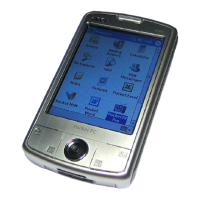
Do you have a question about the Acer n50 and is the answer not in the manual?
| Internal memory | 0.064 GB |
|---|---|
| Built-in processor | PXA272 |
| Processor frequency | 0.312 GHz |
| Display diagonal | 3.5 \ |
| Display resolution | 240 x 320 pixels |
| Display number of colors | 65536 colors |
| I/O ports | 1 x USB 1 x serial |
| Headphone outputs | 1 |
| Bluetooth | Yes |
| Battery capacity | 1060 mAh |
| Battery life (max) | 8 h |
| GPS (satellite) | No |
| RFID reader | - |
| Depth | 120 mm |
|---|---|
| Width | 70 mm |
| Height | 17.4 mm |
| Weight | 150 g |
Information on available guides and how to access them for using the Acer n50 handheld.
Lists the items included in the Acer n50 handheld package for user verification.
Provides instructions on proper care, usage, and resetting procedures for the Acer n50 handheld.
Details the minimum system and program requirements for installing and using ActiveSync with the Acer n50.
Highlights the key performance, display, audio, connectivity, and design features of the Acer n50.
Visual guide to the Acer n50's front, left, top, and bottom views, identifying components.
Step-by-step guide for initial setup, including ActiveSync installation, connection, and charging.
Explains how to interact with the handheld using buttons, stylus, and on-screen elements like the Today screen and menus.
Guide on managing schedules and appointments, including creating and editing entries.
Instructions for managing contact information, creating new contacts, and finding existing ones.
How to use the Tasks application to track and prioritize to-do items and manage deadlines.
Instructions on creating and managing notes, including text, drawings, and recordings.
Guide to sending, receiving, and managing email messages on the handheld, including synchronization.
Details on using Pocket Word for document creation, editing, and synchronization with a PC.
Instructions for creating and managing workbooks using Pocket Excel, including protection and tips.
Guide to using MSN Messenger for instant messaging, setting up accounts, and managing contacts.
Information on using the player for digital audio and video files on the handheld.
Guide to reading eBooks, downloading books, and using reader features like annotations.
Steps to perform manual data backup, including selecting storage and defining backup scope.
How to configure automatic data backup based on battery level or other criteria.
Procedures for restoring backed-up data to the handheld and deleting files from storage.
Instructions for inserting and removing SD/CF cards to expand memory and perform backups.
Steps for connecting and using USB thumb drives via cradle or sync cable for data access.
Overview of synchronizing data between handheld, PC, and Exchange server using ActiveSync.
Guide on sending and receiving data via infrared or Bluetooth connections.
Instructions for establishing modem, Bluetooth, and wireless Ethernet connections to the Internet.
How to connect to work networks using modem, wireless Ethernet, or Bluetooth connections.
Explanation of synchronizing and using favorite links and mobile favorites for offline browsing.
Guide to browsing favorite pages, channels, and the web without an active internet connection.
How to access and modify personal, system, and connection settings on the handheld.
Steps for installing new applications via ActiveSync or Internet, and removing existing ones.
Overview of Bluetooth capabilities, including device discovery, connection, and security features.
Details on configuring Bluetooth settings like user profiles, device name, and service management.
Guide to creating, managing, and using Bluetooth connections with remote devices.
How to use the Bluetooth browser to search for and connect to other Bluetooth devices.
Information on using services like Dial-up Networking, File Explorer, and sending data via Bluetooth.
Regulatory compliance information regarding energy efficiency, FCC rules, and shielded cables.
Notices related to peripheral devices, operation conditions, and Canadian regulations.
EU Declaration of Conformity and essential safety instructions for product operation and maintenance.
Notices on LCD pixels, copyright protection, radio devices, and general compliance.
Information on EU member states, FCC RF safety, Canadian regulations, and human RF field exposure.
Explanation of wireless LAN card status icons displayed in the system tray.
Steps to enable and connect to available wireless networks using the WLAN utility.
How to modify IP address, server settings, and network adapter configurations.
Details on status tabs, configuring network adapters, and using 'More' or 'SiteSurvey' tabs for network info.